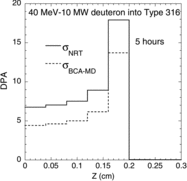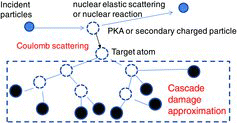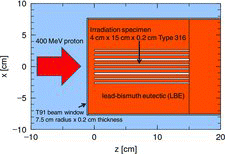Figures & data
Figure 2. The recoil energy spectra produced in copper at fast neutron, 14-MeV neutron and 1-GeV proton irradiations. For fast neutrons, the distribution of energies is 53% in the range 0.1 < En < 0.5 MeV, 29% in the range 0.5 < En < 1 MeV, and 18% in the range 1 < En < 2 MeV, respectively.

Table 1. The displacement threshold energies, Tthreshold, used in the PHITS.
Figure 3. Defect production efficiency versus the damage energy. Curves were fitted based on the calculation with BCA and MD [Citation19].
![Figure 3. Defect production efficiency versus the damage energy. Curves were fitted based on the calculation with BCA and MD [Citation19].](/cms/asset/9eff135a-c06e-4909-a939-0aff5d346f17/tnst_a_851042_f0003_b.gif)
Figure 4. The calculated displacement cross-sections, σNRT and σBCA–MD, for iron irradiated with protons, neutrons, and deuterons.

Figure 5. The displacement cross-sections, σNRT and σBCA–MD, for Type 316 and T91 irradiated with protons, neutrons, and deuterons. The cross-section σBCA–MD includes the displacement cross-section for iron only with defect production efficiency.
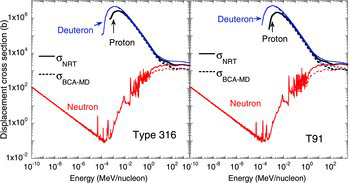
Figure 6. The displacement cross-sections versus incident energy of protons (black line) and neutrons (red line). Solid and dashed lines are the results that were calculated from the PHITS and KIT data [Citation12], respectively.
![Figure 6. The displacement cross-sections versus incident energy of protons (black line) and neutrons (red line). Solid and dashed lines are the results that were calculated from the PHITS and KIT data [Citation12], respectively.](/cms/asset/198d749f-7122-4dcc-aedb-5b8458c9a036/tnst_a_851042_f0006_oc.jpg)
Figure 7. The displacement cross-sections versus incident energy, for energies ranging from 0.1 MeV to 3 GeV, for protons (black) and neutrons (red). The defect production efficiency, η, was set as 1 for the NRT curves (solid lines) and η was included for the BCA–MD curves (dashed lines).
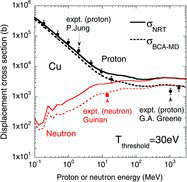
Table 2. The calculated and experimental displacement cross-sections in aluminum and copper irradiated with fast neutrons [Citation23] and 14-MeV neutrons [Citation24], and in copper and tungsten irradiated with 1.1- and 1.94-GeV protons [Citation3,Citation25]. For the PHITS calculations, the cross-section σBCA–MD for aluminum was derived with the averaged ⟨η⟩ given as in [Citation19].
Table 3. The DPA values and the ratio of the atomic parts per million (appm) of helium and hydrogen production to DPA value at the top of irradiation specimen and the center of beam windows for TEF-T calculated using σNRT and σBCA–MD. The calculated data taken from the ESS report [Citation27,Citation29] at the center of a stainless steel beam window of spallation source at ESS are also listed.
Figure 9. Depth dependence of the DPA value for 0.2 × 4 × 15 cm irradiation specimen irradiated by 400 MeV–250 kW proton beam with 4500 hours of irradiation time and using σNRT.

Figure 10. Comparisons of various data on appm/dpa ratios without defect production efficiencies as a function of the energy of incident protons (this work with a T91 beam window irradiated with 400-MeV protons, the ESS report data that was obtained by using a stainless steel irradiated with 1.3-GeV protons [Citation27,Citation29], and results that were calculated by Lu et al. using an iron irradiated with 0.8-, 1.0-, and 2.0-GeV protons [Citation27, Citation30]).
![Figure 10. Comparisons of various data on appm/dpa ratios without defect production efficiencies as a function of the energy of incident protons (this work with a T91 beam window irradiated with 400-MeV protons, the ESS report data that was obtained by using a stainless steel irradiated with 1.3-GeV protons [Citation27,Citation29], and results that were calculated by Lu et al. using an iron irradiated with 0.8-, 1.0-, and 2.0-GeV protons [Citation27, Citation30]).](/cms/asset/1bd5b44d-3654-46c6-b51b-251f0f1e6a5c/tnst_a_851042_f0010_b.gif)
Figure 11. DPA distributions in 0.2 × 4 × 15 cm Type 316 irradiated with the beam of deuterons with incident energy of 40 MeV and a beam power of 10 MW, with 5 hours of irradiation time using σNRT and σBCA–MD.
